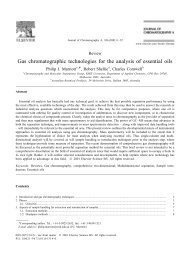FARMACIA, 2010, Vol. 58, 1 51significant increase <strong>of</strong> <strong>the</strong> monoterpenes level <strong>from</strong> 12.55% (2002), 13.96%(2001) to 19.29% (2003). Generally, <strong>the</strong> decrease <strong>of</strong> <strong>the</strong> aromatic fractioncontent was accompanied by an increase in <strong>the</strong> monoterpene levels.The amount and composition <strong>of</strong> <strong>the</strong> <strong>oils</strong> seem to correlate with <strong>the</strong>meteorological data. Colder atmospheric and surface soil temperature (figures2, 3) and abundant rainfall (figure 4) at <strong>the</strong> beginning <strong>of</strong> <strong>the</strong> vegetation perioddetermined lower volatile oil yield and higher level <strong>of</strong> monoterpene for 2003(2%; 19.29%, respectively) compared to 2002 (12.6%; 12.55%) and 2001(11%; 13.96%) years.The effect <strong>of</strong> <strong>the</strong> meteorological factors on <strong>the</strong> oilcomposition is also determined by <strong>the</strong> plant development phase.Surface soil temperature (Celsius grade)35302520151050MarchAprilMayJuneJulyAugustSeptemberOctober200120022003Figure 2Surface temperature soil (°C) <strong>of</strong> 2001-2003 years, March-October intervals(monthly average data)Atmospheric temperature (Celsius grade)2520151050MarchAprilMayJuneJulyAugustSeptemberOctober200120022003Figure 3Atmospheric temperature (°C) <strong>of</strong> 2001-2003 years, March-October intervals(monthly average data)
52FARMACIA, 2010, Vol. 58, 1Rainfall (mm/m 2 )200180160140120100806040200200120022003MarchAprilMayJuneJulyAugustSeptemberOctoberFigure 4Rainfall (mm/m 2 ) <strong>of</strong> 2001-2003 years, March-October intervals(monthly average data)ConclusionsThe <strong>essential</strong> oil <strong>of</strong> <strong>fennel</strong> <strong>fruits</strong> (Foeniculum vulgare Mill.)cultivated in Iasi (Romania) showed a characteristic <strong>chemical</strong> <strong>pr<strong>of</strong>ile</strong> <strong>from</strong>year to year. While t-anethole, estragole, fenchone and limonene were <strong>the</strong>main components in all <strong>oils</strong>, qualitative and quantitative differences incomposition were observed. The content and its monoterpenes componentswere <strong>the</strong> most susceptible features <strong>of</strong> <strong>fennel</strong> <strong>essential</strong> oil to be affected byclimatic conditions (temperature and rainfall).References1. Bernath J., Nemeth E., Pe<strong>the</strong>o F., Mihalik E., Kalman K., Franke R.- Regularities<strong>of</strong> <strong>the</strong> <strong>essential</strong> oil accumulation in developing <strong>fruits</strong> <strong>of</strong> <strong>fennel</strong> (Foeniculumvulgare Mill.) and its histological background, J.Essent. Oil Res., 1999, 11, 431-438;2. Rădulescu V., Pavel M., Teodor A., Tănase A., Ilieş D.C., Analysis <strong>of</strong> volatilecompounds <strong>from</strong> infusion and hydrodistillate <strong>obtained</strong> <strong>from</strong> <strong>the</strong> species Thymuspulegioides, Farmacia, 2009, 57(3), 282-2893. Choi E.M., Hwang J.K. - Antiinflammatory, analgesic and antioxidant activities <strong>of</strong><strong>the</strong> fruit <strong>of</strong> Foeniculum vulgare, Fitoterapia, 2004, 75 (6), 557-565;4. Misharina T. A., Polshkov A. N. - Antioxidant properties <strong>of</strong> <strong>essential</strong> <strong>oils</strong>:autooxidation <strong>of</strong> <strong>essential</strong> <strong>oils</strong> grom laurel and <strong>fennel</strong> and effects <strong>of</strong> mixing wi<strong>the</strong>ssential oil <strong>from</strong> coriander, Prikl Biokhim Mikrobiol., 2005, 41 (6), 693-702;5. Toma C., Pancan I., Chiriţă M., Zamfir A., Electrospray ionization tandem massspectrometric investigation <strong>of</strong> Melissa <strong>of</strong>ficinalis oil, Farmacia 2008, 56(1), 92- 98











![Bericht von Schimmel & Co. [Inhaber Gebr. Fritzsche] in Leipzig](https://img.yumpu.com/24438150/1/171x260/bericht-von-schimmel-co-inhaber-gebr-fritzsche-in-leipzig.jpg?quality=85)




